
New Managing Director for Bellona Norway
The Board of the Bellona Foundation has appointed former Minister of Climate and the Environment Sveinung Rotevatn as Managing Director of Bellona No...
News

Publish date: September 8, 2014
News
NEW ORLEANS/HOUMA, Louisiana – Scott Porter, a scuba diver, marine biologist and self-declared surf-bum from Malibu seems an unlikely candidate to challenge the consolidated bulk of information the US National Oceanic and Atmospheric Administration (NOAA) says it’s amassed on the effects of the Deepwater Horizon spill and its ongoing impact four years later.
His lab is packed with aquariums and buckets filled with coral harvested from Gulf of Mexico oil platforms, which is allowed under US law. The troughs bubble along, revealing a mucoid goo and producing the rainbow sheen characteristic of oil not mixing with water.
His voice comes out as smooth as Coppertone suntan lotion and his long hair is tied back in a loose sun bleached ponytail as he shuffles in flip-flops through his caldrons of horrors.
The twisted, sooty coral he’s running tests on offer indispensible clues on where the oil and dispersant called Corexit from the 2010 BP spill are still lying below the placid surface of the Gulf and the reeds of the wetlands to this day – posing a continuing critical health danger to the Gulf of Mexico’s 40 million residents.
“Coral is an extremely sensitive barometer of what is out there and where it is,” Porter told Bellona from his lab. “That greyish white substance is oil plume,” he said, indicating a foggy water tank holding coral he pulled up in February 2014.

The plumes – an oxygen vacuum amalgam of tiny droplets of crude and the lethal Corexit that can travel hundreds of miles from the spill source, said Porter, are what NOAA and the Louisiana Department of Environmental Quality (DEQ) have said can’t be found in the Gulf any longer.
Yet tendrils of plume are exactly what independent researches documented running through the Gulf back in 2010, some as long as 100 kilometers and 10 meters wide, suspended in the water column for months after the spill. According to Porter’s calculations, 70 percent of the Gulf’s natural and artificial reefs are now “dead zones” thanks to the BP spill.
The science on plumes is sparse because the BP spill is the first time they’ve been seen, probably as a result of BPs experiment in deploying Corexit underwater, which was an untested use of the chemical, along with the 1.85 million gallons of Corexit it dumped from planes.
What has become of them is something no government agency wants, or is allowed, to say. But Porter’s research suggests the elusive beasts are still at sea.
It’s a solitary mission.
Undead plumes
“Among the whole alphabet soup of NOAA and DEQ, that’s one word you will never hear from them: plume,” said Porter.
“They won’t acknowledge they ever existed in Louisiana state waters because [Louisiana Governor Bobby] Jindal said he banned Corexit from being dumped within three miles of the state’s shores, but there it is – plume, four years later,” he says, pointing to a bucket of mutant coral clouded over by cumulous wisps of what looks like fetid milk.
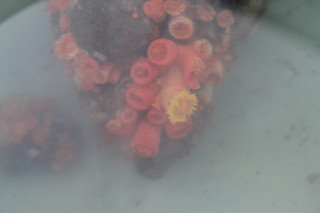
Indeed, Jindal’s office returned comment to Bellona saying Corexit was never sprayed “on or near Louisiana’s coast,” a claim given the lie by dozens of witnesses and researchers besides Porter that were interviewed by Bellona.
Porter’s research has charted a rough 1000-square mile territory stretching from 100 miles west of the Macondo well, and up the east coast of the state to about 40 miles southeast of New Orleans offering solid clues as to where the crude and Corexit from the spill has settled in the water column.
Porter’s dives for ailing coral have also mapped tar mats at the bottom of the sea, some as long as 12 miles according to his documentation, and three to six feet deep.
This could account for the mass seafood deformities and animal deaths – as well as Porter’s assertion that he will no longer eat any seafood coming from south of Bayou Eloi, some 80 miles east-southeast of New Orleans.
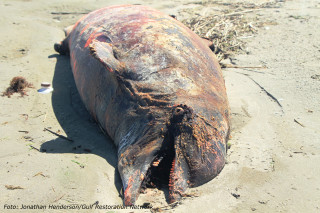
Porter admits that his research is incomplete. He’s not trying to do the government’s job – only force the government to theirs.
“Even if the NOAA was correct back in 2010 and 75 percent of the oil just ‘evaporated,’ that still leaves 20 million barrels unaccounted for,” said Porter. “Where did it go? I’m not surprised if I stumbled over a big piece of it, if not more.”
This is entirely plausible, according to scientific studies from as far south as Florida to as far north as Woods Hole, Massachusetts.
As soon as NOAA forwarded its evaporation theory, scientists from the University of South Florida showed they found oil deep on the Gulf seafloor, and that it was virulently toxic to marine microorganisms. The University of Georgia also released calculations that 70 to 79 percent of the oil remained underwater.
And in a major peer-reviewed article in Science magazine, scientists at the Woods Hole Oceanographic Institution described their discovery in June 2010 of a plume of hydrocarbons at least 22 miles long and more than 3,000 feet below the surface of the Gulf of Mexico – a measurement making the plume as big as Manhattan.

Dreams buried in tar
In 1991, Porter traded in his surf wax for degrees in marine biology and a certification in oil spill consultation and moved from California to Louisiana in search of its resplendent coral reefs.
His dream was to go into aquaculture in Louisiana’s wetlands. Particularly, he intended to raise the coveted cobia fish in a record-breaking 12 months in the right waters. He would pay for this endeavor by harvesting from the Gulf’s 4000 oilrigs’ diverse corals, some of which are found in only narrow slivers of sea halfway around the world in Southeast Asia.
The names of the corals he reels off are unpronounceable, but the biomedical potential of their enzymes could, he said, revolutionize cancer studies. But then, the oil and dispersant washed in, destroying his aquaculture farms.
“Now that dream is dead,” he said. “The coral – well, that sucked up the BP poison.”
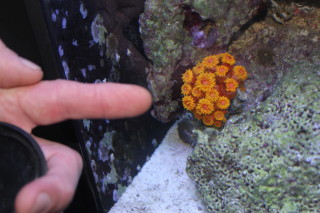
Porter’s inside view of diving for NOAA
As a scuba diver for at Ecorigs – which, in an ironic twist, fights for the preservation of Gulf oil platforms because of the abundant coral reef and aquaculture habitats they support – Porter was recruited by NOAA right after the April 2010 gusher to take extremely dangerous underwater oil samples.
He and his team applied the knowledge they knew best – testing coral for oil and dispersant saturation. The levels were off the charts.
By August of that year, when the political tides at NOAA shifted away from determining sea toxicity levels to saying the sea was not toxic, the agency started ignoring Porter’s coral samples, which continued to show extremely high concentrations of oil and dispersant.
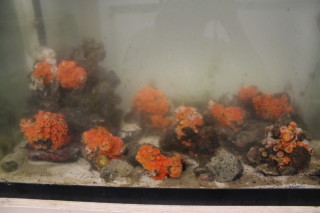
“NOAA is the biggest know nothing, do nothing, stick-its-head-in-the-sand agency involved with the spill,” he said. “The priority went from science to politics and they wanted to say, via whatever concocted scientific methodology, that the oil was gone.”
That methodology, said Porter, amounted in the end to so called “amber bottle” tests, where mere milliliters of surface samples were collected and declared clean – offering no information on the plumes evidenced in Porter’s coral samples that lurked far below.
Oil and dispersant concentrating in water column and food chain
Written off by the government agencies that used to trip over each other to consult him, Porter struck out on his own with his colleagues at Ecorigs and reached some shocking conclusions.
The lab test he has been running on coral samples is called depuration, a process that aids the organisms in expelling the toxic substances contained within them, with the aim of rehabilitating them.
But samples selected for depuration are often impossible to get back to his lab at Ecorigs.
“Sixty to seventy percent of the samples I collected on [the February] dive didn’t pass quarantine,” he said. These samples are marred with obsidian-black growths, malignancies and deformities, ruling them out as candidates for rehabilitation.
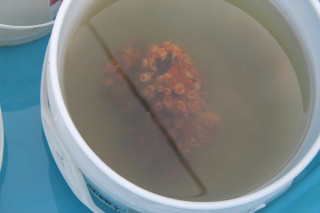
The coral samples come from the artificial reefs around the same oil rigs he’s been diving since 2010. He videotapes the conditions and culling coral samples some 100 miles southwest of where BP’s Macondo well blew.
And he’s followed the path some 250 miles up the state’s meandering and dipping coast to St. Bernard Parish, 30 miles southeast of New Orleans, charting the dying coral and fallow, oil-greased oyster beds along the way.
Time-lapse images to Armageddon
The images in his video project descend from a flurry of color and the birdlike veering of schools of fish in 2010 to an anthracite moonscape of Pompeian dust devoid of any life – a lurid send up of Jules Verne’s classic that could be called: 20,000 Leagues Under That You Didn’t Want to See.”
The coral samples, releasing the smell of crude and the dispersant Corexit in his lab were taken from Porter’s last dive in February 2014. While diving oil rescue for NOAA in 2010, Porter said NOAA was pushing to reach a toxicity level, or LC50, of 2 parts oil per million of water.
“If you can smell it, you’re talking about more like 20 parts per million,” he said. “This is what it smelled like in 2010,” referring to the headache inducing odor of a leaky lawnmower swirling around the lab.
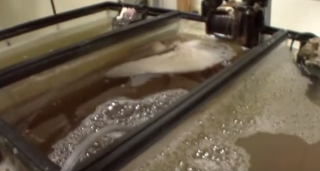
This smell is still present in the environment and frequently after storms and high tides along the shores and wetland areas of Venice, Grand Isle, Elmer Island, former oyster bonanza spots like Barataria Bay, Point Jimmy, Cocotrie, Point a la Hache, the brackish Lake Machias, Delcroix, Hopedale, Black Bay, and Bayou Eloi, St. Bernard Parish and Plaquemines Parish, as evidenced during numerous south to north road trips Bellona has taken over the past month, Porter’s accounts, and the recounting of locals Bellona spoke with along the way.
Porter’s conclusions
Porter says his four-year-long analysis of coral proves a couple of things.
The first is that Macondo signature oil is still out there in massive quantities, concentrated in the water column and settled along the sea bottom in huge tar mats, causing severe skin rashes particularly among children who spent time on Gulf beaches this summer.
“The oil is difficult to fingerprint because Corexit was designed to break it down to a molecular level – and that was the whole idea of dispersant application: to make the oil unrecognizable and present a veneer of plausible deniability for BP,” said Porter. “But when you know what the remaining metabolites look like, you can find it.” This is precisely what he says his coral dives are showing.
The second conclusion he came to is that the oil and dispersant is concentrating within the gulf seafood supply, which could eventually show baleful and unpredictable results in human seafood consumers.
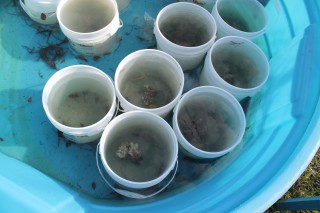
The carcinogenic effects documented the Gulf’s oyster, shrimp, blue crabs and Bluefin Tuna are too great not to cause human health issues down the road, he said.
“The oil an dispersant is a gumbo of carcinogenic compounds,” said Porter, “and it’s gathering in the food chain.”
Some cautious scientific disagreement…for now
Not all scientists and fishermen interviewed by Bellona agree with Porter’s assessment that a human impact is imminent – but none of them are binning the notion either.
“I eat shrimp all the time,” said Captain George Barisch, a Louisiana shrimp and oyster fisherman who participates in inspecting seafood for evidence of oil spill related contamination at sea via a nonprofit effort. The federal government seems to be lagging behind in such tests. Barisch, who is also president of the United Commercial Fisherman’s Association in Louisiana, says the government’s primary criteria for testing seafood is a so-called “sniff test.”
This entails Food an Drug Administration (FDA) inspectors randomly choosing sacks of seafood and smelling them for chemical odors. If none are detected, the fish pass muster and the inspectors clear them for pubic market.
According to an FDA information sheet from August 7, 2014, sniff testing remains the primary mode of determining seafood’s fitness for market. If fish from certain fishing grounds that “were contaminated by oil” fail sniff tests, reads the memo, samples are sent on for polyaromatic hydrocarbon (PAH) screening. But fishermen say this happens so rarely it’s not noticeable.
Barisch considers he FDA’s sniff test protocol ludicrous. Still, based on his own hands-on observation he still asserts that “whether we have contamination of seafood is a question of bioaccumulation, and we won’t see any results of that for a very long time.”

Even so Barisch, whose oyster harvest has plummeted to 93 percent of his harvests in 2010, said he refuses to sell oysters he can catch in his BP contaminated beds for fear of making consumers ill.
Dr Wilma Subra, a Macarthur “genius grant’ fellowship-winning environmental scientist cited the difficulties of separating those who could become sick from seafood consumption from those who are already ill from the well documented environmental illnesses associated with exposure to Corexit, including a spike in cancer rates.
“The two would be very hard to separate, especially because the symptoms of exposure to Corexit during cleanup operations and exposure to toxins because of seafood ingestion would be basically indistinguishable,” she said. “Illness via either method is caused by ingesting, breathing or absorbing the carcinogens.”
Proving a negative
Karl Kristensen, the Bellona Foundation’s expert on industrial waste, said that coral in certain circumstances is almost too sensitive a barometer of the toxins concentrated in the sea.
“It depends on what you are testing the coral for and how long it has been exposed to the particular toxin you are trying to identify,” he said. “Since the samples under consideration [by Porter] were taken in February 2014, they are probably presenting an accurate picture of things provided no other drastic toxins have contaminated them.”
Kristensen said that the biggest problem is proving the negative – which seafood has not been contaminated by human life threatening carcinogens, and is confused about why the United States government has not been at pains to more scientifically prove this than by relying on the human noses of FDA agents.
“We could purchase 10,000 pounds, or 100,000 pounds of seafood and examine them for changes causing life threatening conditions in consumers and even then, we would only be able to assert that this particular seafood is safe,” he said. “But an effort like that takes government level funding to undertake.”
Conversely, argued Kristensen, if two, five or 10 tons of seafood turned up fatal oil spill related toxins, the US government would be responsible for determining the source.
Porter himself tried the ad-hoc method of purchasing 700 mutated, purulent growth-riddled blue crabs pulled up in the nets of shrimpers off Grand Isle in early August. He wanted to run depuration tests on them and see what toxins they released.
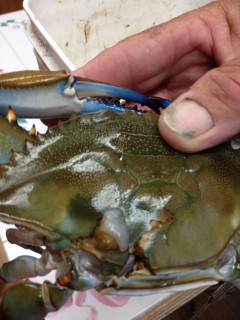
But only 26 of the 700 crabs survived for more than six days after they came out of the sea, making it impossible to test them. But the gargantuan die off points to lethal toxic exposure.
Kristensen said that the US government should be conducting some studies on the ongoing laundry list of bad news still issuing from the Gulf, but is perplexed that barely any of it is being made public.
“It’s shocking there is not a higher level of transparency that would corroborate or disprove what independent scientists and Gulf fishermen are showing,” he said.
Government resists offering real proof
Those interviewed by Bellona agree that Porter’s research threatens the sandcastles of evidence NOAA, the US Environmental Protection Agency (EPA), the FDA, BP and even President Obama have submitted as proof that Gulf seafood is safe– proof that is at best anecdotal.
On August 13, 2010, Obama pronounced gulf seafood safe to eat after a lunch of shrimp in Mississippi. He then promised, as quoted by the Associate Press, that, “Things are going to return to normal […] I am confident that we’re going to be able to leave the Gulf Coast in better shape than it was before.”
The pledge was reminiscent of George W. Bush’s promise to rebuild the region “even better and stronger” than before Hurricane Katrina in 2005. Bush never made good on that promise, and others besides Porter have noted Obama has failed his own Gulf crisis.
In April this year, BP shut down its cleanup operations altogether saying the beaches and the water are clean. Record breaking quantities of dead sea life and Corexit tainted tar balls meanwhile continue to wash up on beaches from Venice, Louisiana to Dauphin Island, Alabama.

Government gagged
So, what does the government have to say now?
Because of a National Resources Disaster Assessment (NRDA) that started the day of the blowout, it doesn’t have to say much at all, and hasn’t. The NRDA has so far restricted NOAA, the FDA, the EPA, the US Coast Guard, other stakeholders and their state-level wildlife and marine agencies from releasing any information pertinent to public health.
When asked several times by Bellona to comment on the specifics of Porters findings, it received a reply from New Orleans-based NOAA spokesman Ben Sherman.
Sherman wrote in an email that, “The ongoing Deepwater Horizon NRDA is the most transparent in history, but as the basis for the legal case holding the responsible parties accountable for the damages, the Trustee Council and its member agencies including NOAA, cannot make all findings public at present due to that litigation.”
The email went on to refer Bellona to NOAA’s website on the spill’s ongoing effects, which contains little information aside from restoration ideas, endangered species rehabilitation plans, and cost analyses. There is no mention at all of addressing the pervasive human health issues that have recently come to light in staggering numbers, such as cancer.
“The NRDA has released absolutely nothing about health because they are not focusing any efforts on it,” Porter said. “Ecological projects are a lot easier to advertise and protect BP from any liability to those of us who are sick or dying.”
Though Porter is reluctant to admit it, he falls in that category. His mellow voice is often interrupted as he grasps for the right word. His skin shows signs of pigmentation loss from scorching rashes that break out, forming hard nodules on his skin. He’s showing the classic signs of toxic exposures to Corexit.
Government ignores EPA directives against oil rescue diving
Porter could have been spared this insult. As early as July 2010, the EPA voiced concerns to NOAA about sending its divers into the toxic plumes, and eventually forbad it, according to government correspondence obtained by Bellona.
Of particular concern were “the micro-bubbles of oil that are now in the water column – thanks to the dispersant – and take a day or more to reach the surface” according to the correspondence.
The EPA communiqués further evidenced knowledge of serious illnesses that exposure to Corexit could cause: “Even if the diver doesn’t get sick immediately, in this case we’re looking at possible exposure to crude oil (oil and dispersants) –components of which could increase your lifetime cancer risk.”
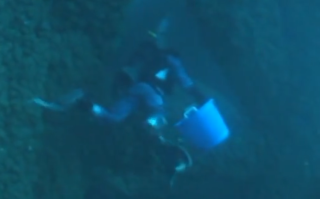
A July 7, 2010 memo from the NOAA to the EPA regarding divers’ gear, reads: “Traditional scuba equipment does not provide adequate protection for the diver who must operate in contaminated water. Wet suits are designed to permit water to enter the suit at the wrists, neck and ankles […] Any chemical or biological agent that can be absorbed through the skin presents an immediate hazard if a wet suit is worn.”
The EPA concluded its correspondence by responding on the same day: “Our basic recommendation for our own EPA operations is that divers that haven’t been doing this for a period of time should not attempt to do it ‘on the fly’ in the Gulf within the areas the NOAA Office of Restoration and Response have shown oil to be present or potentially present—the most likely outcome is that divers will be acutely exposed, or unnecessarily increase their chances of showing long term effects down the road.”
NOAA ignored the directive, and continued to send Porter and his colleagues in to sample the plumes. Porter told Bellona the chemicals they were forced to dive in ate away the vulcanized rubber of their wet suits. Porter switched to a dry-dive suit, which covered his head and limited liquid exposure to his skin. But that, too, was chewed away by chemicals.

He is now “showing long term effects down the road.”
The Gulf’s worst disaster
As the government keeps mum on the effects of the oil and dispersant, as more and more people turn up ill, as more and more evidence emerges that the BP spill is a permanent resident within the Gulf’s ecosystem for decades to come, one begins to wonder just how big a blanket of ignorance and misinformation NOAA and other associated agencies can weave to conceal the truth.
The only hope, it seems, lies in amplifying and unifying the public voice and giving it a bigger megaphone, said Dr Subra.
“The obvious tactic is to keep victims of the spill isolated from each other so that only the unified disinformation of the government sees the light of day,” she said.
Marylee Orr is the executive director of the 28-year-old Louisiana Environmental Action Network (LEAN). Her organization has done more to organize health data on the spill, public or private, since the day the BP oil levee broke.
Because of its quarter-century existence, LEAN has literally been through the hell and high water of hurricanes – namely Katrina in 2005 – and has seen its share of government bumbling, environmental devastation, bureaucratic mismanagement and official incompetence.
But even these events, she says, are dwarfed by the Deepwater Horizon spill.
“The BP spill was the mother of all mothers. It’s the single worst thing that has happened to the Gulf,” Orr told Bellona. “It just keeps giving and giving – and it’s not going away.”
For Bellona’s Kristensen, all of the government obfuscating and hide and seek is simply intolerable and must end if anyone is to be convinced of the assertion that the oil spill poses no further harm.
“It is the government’s responsibility to demonstrate transparency and immediately make available science that the spill poses no danger,” he said. “So far, their actions have provided nothing but a basis for more fear.”
In a final request for comment phoned in by Bellona to NOAA’s headquarters in Washington DC, Bellona asked “how long do you think you can continue hide behind the NRDA and refuse to distribute useful public health information to the American Public – how ignorant do you intend to keep it?”
The switchboard spokesperson said: “Due to the ongoing litigation of which NOAA is a principle, we can’t publicly disclose any figures on that.”

The Board of the Bellona Foundation has appointed former Minister of Climate and the Environment Sveinung Rotevatn as Managing Director of Bellona No...

Økokrim, Norway’s authority for investigating and prosecuting economic and environmental crime, has imposed a record fine on Equinor following a comp...

Our op-ed originally appeared in The Moscow Times. For more than three decades, Russia has been burdened with the remains of the Soviet ...

The United Nation’s COP30 global climate negotiations in Belém, Brazil ended this weekend with a watered-down resolution that failed to halt deforest...